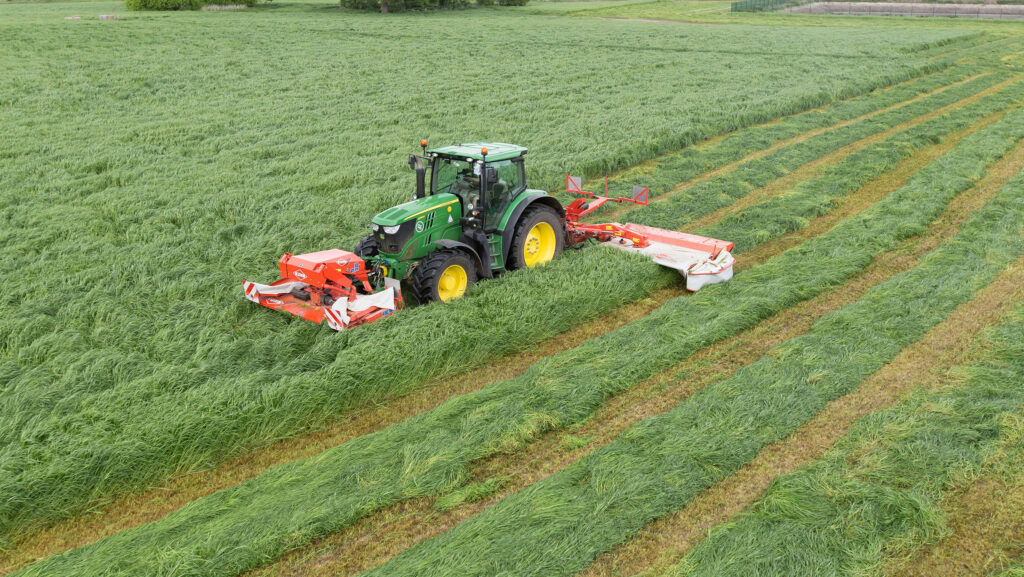Farmers urged to use safety checklist ahead of silage season
 © Tim Scrivener
© Tim Scrivener Farmers are reminded to prioritise safety as many prepare to start first-cut silage making, following one of the wettest winters on record.
Rural insurer NFU Mutual has released a silage checklist after expressing concern for farmer safety as waterlogged fields could increase the risk of trailers overturning on hillsides, blocking machinery, and leaving mud on roads.
See also: Top farming safety tips from Farmers Weekly readers
This year has seen the results of the eighth-wettest winter on record, coupled with heavy rainfall throughout the spring, leaving many farmers behind with slurry and fertiliser spreading.
The recent mild weather means that grass in some areas is ready to cut earlier than usual.
Bob Henderson, NFU Mutual’s head of engineering, said that farmers should make contingency plans for their first cut of silage, to ensure they can cope with wet field conditions.
“Just how much of a problem waterlogged fields will be will depend on the weather in the week before harvesting,” he explains. “If we get a dry spell, most fields will dry up well, apart from poorly-drained spots.
“However, continuing rain is likely to lead to higher risks of machinery getting bogged down, mowers and forage harvesters getting blocked and a higher risk of tractors and trailers losing grip and turning over on slopes.
“Farm incidents tend to happen when people are tired, machinery is pushed too hard or work continues in unfavourable conditions. It is vital to carefully assess field conditions and working within safe limits. No cut of silage is worth someone’s life or limb.”
Silage safety checklist
NFU Mutual has complied a comprehensive silage safety checklist – including measures to take before leaving the farm, during first cut, and while working in silage clamps.
Before silage harvesting
- Make sure you have identified and assessed the hazards on the farm, in the field, and the tasks that will be conducted during silage harvesting, and know how to manage the risks
- Walk silage fields before cutting to identify wet spots and any potentially dangerous slippery slopes
- Put in place a system for keeping in contact with lone workers
- Make sure new staff are properly inducted and trained for the work you give them – in particular the dangers of working with and around farm machinery
- Teach staff about the principles of “Safe Stop”: Make sure the handbrake is fully applied; controls and equipment are left safe; stop the engine; and remove the key, before leaving the vehicle or accessing the machine
- Put in place measures to ensure children are kept away from working areas
- Make sure staff know the safe working loads of trailers and don’t allow trailers to be overfilled
- Ensure vehicles and trailers are road legal with fully maintained and working brakes, lights, indicators and flashing beacons. Also check the age, condition and pressures of tyres. Consider using a third party to inspect trailers, with accreditation such as the ‘Tilly Your Trailer’ scheme
- Consider letting local people know when you will be taking silage trailers on local lanes via neighbourhood social media sites to help people reroute journeys as this will cut delays and incident risks
Working in the fields
- Make sure tractors have sufficient power and braking capacity to control trailers on slippery hilly fields
- Regularly check moving parts of mowers, tedders, forage harvesters and balers, including guards and PTO shafts for wear or damage
- Switch off engines and ensure parts have stopped before clearing blockages or carrying out maintenance – remove keys as well to prevent accidental starting (Safe Stop!)
- Make sure drivers are aware of the locations and heights of overhead power lines and check that your machinery will safely pass under wires and restrictions, especially where there is a risk of overturn with vehicles potentially being at a different angle
- Take special care to check for vehicles following behind before turning right into fields or yards, as this is a common cause of accidents
- Regularly clear up any mud deposits from roads – alert drivers with signage where mud may be present
- Be aware of potential walkers in fields with public rights of way and stop the vehicle if people are in close proximity
- Keep a mobile phone on you at all times – not left in a tractor or pick-up cab
- Take regular breaks to eat, drink and rest to stave off tiredness
Working on silage clamps
- Keep people away from moving vehicles
- Ensure a filling plan is followed and that sight rails are visible at all times
- Never overfill a silage clamp as this increases the risk of vehicles overturning when rolling or filling
- Only use vehicles that are suitable for the task – fitted with an approved safety cab or Roll over Protection Structure (RoPS), well-lugged tyres, suitably weighted
- For indoor clamps, keep away for the first 72 hours as this is when dangerous nitrogen dioxide gas can form in large quantities
- Keep clear of the edge of the clamp (at least 1m) when (un)sheeting or removing tyres
